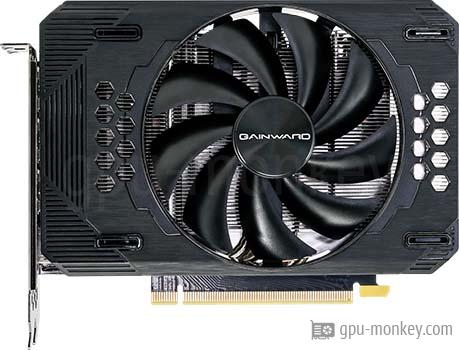
Gainward GeForce RTX 3050 Pegasus
Benchmark & Confronto GPU
Ultimo aggiornamento:
Benchmark & Confronto GPU
Qui ti mostriamo benchmark e dati tecnici per Gainward GeForce RTX 3050 Pegasus. La scheda grafica è basata su NVIDIA GeForce RTX 3050 (Ampere) e dispone di 8 GB GDDR6 di memoria grafica con una larghezza di banda di memoria di 224 GB/s. Gainward GeForce RTX 3050 Pegasus ha 20 unità di esecuzione con 2560 shader.
GPUGainward GeForce RTX 3050 Pegasus ha 2560 shader e 20 unità di esecuzione. La scheda grafica raggiunge così una potenza di calcolo FP32 teorica di 9,10 TFLOPS. |
|
| Basato su: | NVIDIA GeForce RTX 3050 |
| GPU Chip: | GA106-150-A1 (Ampere) |
| Multiprocessori in streaming: | 20 |
| Shader: | 2560 |
| Render Output Units: | 48 |
| Texture Units: | 80 |
| Raytracing Cores: | 20 |
MemoriaGainward GeForce RTX 3050 Pegasus può utilizzare 8 GB di memoria grafica del tipo GDDR6. La scheda grafica raggiunge così una larghezza di banda della memoria di 224 GB/s su un'interfaccia di memoria a larghezza di bit 128. |
|
| Dimensione della memoria: | 8 GB |
| Tipo di memoria : | GDDR6 |
| Orologio di memoria: | 1,750 GHz |
| Velocità: | 14,0 Gbps |
| Banda di memoria: | 224 GB/s |
| Interfaccia di memoria: | 128 bit |
Velocità di clockLa frequenza di clock di base di Gainward GeForce RTX 3050 Pegasus è 1,552 GHz. Una frequenza di clock elevata (anche in modalità turbo) può aumentare notevolmente la velocità di una scheda grafica. |
|
| Frequenza di base: | 1,552 GHz |
| Frequenza turbo: | 1,777 GHz |
| Frequenza media: | |
| Overclocking: | Si |
Design termicoIl TDP (Thermal Design Power) di Gainward GeForce RTX 3050 Pegasus è --. La scheda grafica riceve energia tramite il connettore 1 x 8-Pin. |
|
| TDP: | 130 W (Riferimento) |
| TDP (up): | -- |
| Tjunction max: | 93 °C |
| PCIe-Power: | 1 x 8-Pin |
Dispositivo di raffreddamento e ventoleGainward GeForce RTX 3050 Pegasus ha un totale di 1 Axial ventole per raffreddare il processore grafico e la memoria grafica. |
|
| Tipo a ventaglio: | Axial |
| Fan 1: | 1 x 100 mm |
| Fan 2: | -- |
| Tipo di raffreddamento: | Aria condizionata |
| Volume (inattivo): | 0 dB / Silenzioso |
| Volume (pieno carico): | -- |
ConnettivitàÈ possibile collegare fino a 4 schermi al Gainward GeForce RTX 3050 Pegasus. |
|
| Max. Schermi: | 4 |
| HDCP-Version: | 2.3 |
| HDMI Ports: | 1x HDMI v2.1 |
| DP Ports: | 3x DP v1.4a |
| DVI Ports: | -- |
| VGA Ports: | -- |
| USB-C Ports: | -- |
FeaturesetGainward GeForce RTX 3050 Pegasus ha una risoluzione massima di 7680x4320 pixel. La scheda grafica supporta lo standard DirectX 12_2 (Ultimate). |
|
| Max. risoluzione: | 7680x4320 |
| DirectX: | 12_2 (Ultimate) |
| Raytracing: | Si |
| DLSS / FSR: | Si |
| LED: | Nessuna illuminazione a LED |
Codec video supportatiI codec video accelerati in hardware dal Gainward GeForce RTX 3050 Pegasus riducono il carico del processore e garantiscono un minore consumo energetico. |
|
| h264: | Decodificare / Codificare |
| h265 / HEVC: | Decodificare / Codificare |
| VP8: | Decodificare |
| VP9: | Decodificare |
| AV1: | Decodificare |
DimensioniIl Gainward GeForce RTX 3050 Pegasus è lungo 170 mm e alto 125 mm. Con una larghezza di --, la scheda grafica richiede 2 PCIe-Slots nel case. |
|
| lunghezza: | 170 mm |
| Altezza: | 125 mm |
| Larghezza: | -- |
| Larghezza (slot): | 2 PCIe-Slots |
| Peso: | -- |
Dati aggiuntiviIl Gainward GeForce RTX 3050 Pegasus realizzato in 8 nm è stato pubblicato il Q1/2022 per 249 $ (Riferimento). |
|
| Interfaccia GPU: | PCIe 4.0 x 16 |
| Data di lancio : | Q1/2022 |
| Prezzo di rilascio: | 249 $ (Riferimento) |
| Dimensioni della struttura: | 8 nm |
| codice articolo: | NE63050019P1-190AE |
| Documenti: | scheda dati |
Valuta questa scheda grafica
Risultati di benchmark
3DMark Benchmark (DirectX, Raytracing)
3DMark è un programma di benchmark che determina le prestazioni di alcuni componenti di un computer e quindi riporta le prestazioni come valore numerico.
Time Spy Extreme Graphics score

|
Gainward GeForce RTX 3050 Pegasus
8 GB GDDR6 |
||

|
NVIDIA GeForce RTX 3050
Media del gruppo GPU |
||
Port Royal (Raytracing)

|
Gainward GeForce RTX 3050 Pegasus
8 GB GDDR6 |
||

|
NVIDIA GeForce RTX 3050
Media del gruppo GPU |
||
Speed Way Graphics Score (Raytracing)

|
Gainward GeForce RTX 3050 Pegasus
8 GB GDDR6 |
||

|
NVIDIA GeForce RTX 3050
Media del gruppo GPU |
||
Cyberpunk 2077
Cyberpunk 2077 è stato sviluppato da CD Projekt Red ed è basato sul REDengine 4 dello studio di sviluppo. Il ray tracing è disattivato nei nostri benchmark.
3840x2160 (2160p)

|
Gainward GeForce RTX 3050 Pegasus
8 GB GDDR6 |
||

|
NVIDIA GeForce RTX 3050
Media del gruppo GPU |
||
2560x1440 (1440p)

|
Gainward GeForce RTX 3050 Pegasus
8 GB GDDR6 |
||

|
NVIDIA GeForce RTX 3050
Media del gruppo GPU |
||
1920x1080 (1080p)

|
Gainward GeForce RTX 3050 Pegasus
8 GB GDDR6 |
||

|
NVIDIA GeForce RTX 3050
Media del gruppo GPU |
||
The Last of Us Part 1
The Last of Us Part One è un gioco pubblicato da Sony nel giugno 2013 esclusivamente per Playstation e rilasciato per PC all'inizio del 2023. I valori di riferimento qui sono stati determinati con dettagli elevati.
3840x2160 (2160p)

|
Gainward GeForce RTX 3050 Pegasus
8 GB GDDR6 |
||

|
NVIDIA GeForce RTX 3050
Media del gruppo GPU |
||
2560x1440 (1440p)

|
Gainward GeForce RTX 3050 Pegasus
8 GB GDDR6 |
||

|
NVIDIA GeForce RTX 3050
Media del gruppo GPU |
||
1920x1080 (1080p)

|
Gainward GeForce RTX 3050 Pegasus
8 GB GDDR6 |
||

|
NVIDIA GeForce RTX 3050
Media del gruppo GPU |
||
Battlefield 5
Battlefield 5 è un gioco visivamente sbalorditivo, ideale come benchmark per le schede grafiche. Testiamo il gioco con i massimi dettagli su Windows 10.
3840x2160 (2160p)

|
Gainward GeForce RTX 3050 Pegasus
8 GB GDDR6 |
||

|
NVIDIA GeForce RTX 3050
Media del gruppo GPU |
||
2560x1440 (1440p)

|
Gainward GeForce RTX 3050 Pegasus
8 GB GDDR6 |
||

|
NVIDIA GeForce RTX 3050
Media del gruppo GPU |
||
1920x1080 (1080p)

|
Gainward GeForce RTX 3050 Pegasus
8 GB GDDR6 |
||

|
NVIDIA GeForce RTX 3050
Media del gruppo GPU |
||
Geekbench 6 (OpenCL, Vulkan, Metal)
Geekbench 6 è un benchmark multipiattaforma per i processori principali, che esegue anche 3 diversi benchmark grafici e li emette sotto forma di un valore numerico.
Geekbench 6 - OpenCL

|
Gainward GeForce RTX 3050 Pegasus
8 GB GDDR6 |
||

|
NVIDIA GeForce RTX 3050
Media del gruppo GPU |
||
Geekbench 6 - Vulkan

|
Gainward GeForce RTX 3050 Pegasus
8 GB GDDR6 |
||

|
NVIDIA GeForce RTX 3050
Media del gruppo GPU |
||
Prestazioni FP32 (TFLOPS a precisione singola)
La potenza di calcolo teorica della scheda grafica con precisione singola (32 bit) in TFLOPS indica quanti trilioni di operazioni in virgola mobile FP32 la scheda grafica (GPU) può eseguire al secondo.
FP32 (TFLOPS)

|
Gainward GeForce RTX 3050 Pegasus
8 GB GDDR6 |
||
Più benchmark
Per determinare le prestazioni di una scheda grafica, vengono eseguiti i cosiddetti "benchmark". Il software di benchmark esegue calcoli speciali per determinare le prestazioni di una scheda grafica. Utilizziamo i cosiddetti benchmark teorici o sintetici (ad esempio 3D Mark) così come benchmark di gioco reali. Per garantire una reale comparabilità dei risultati, prestiamo attenzione alla corretta esecuzione dei benchmark nonché alle condizioni della scheda grafica e del sistema.Usiamo i seguenti benchmark per valutare le prestazioni di una scheda grafica:

3DMark Benchmark
5.148 inserimenti
5.148 inserimenti

Cyberpunk 2077
2.942 inserimenti
2.942 inserimenti

The Last of Us Part 1
2.058 inserimenti
2.058 inserimenti

GTA 5 Benchmark
4.624 inserimenti
4.624 inserimenti

Shadow of the Tomb Raider
5.148 inserimenti
5.148 inserimenti

Battlefield 5
4.510 inserimenti
4.510 inserimenti

Geekbench 6
5.151 inserimenti
5.151 inserimenti

Crypto-Mining Ethereum Hashrate
3.506 inserimenti
3.506 inserimenti

Crypto-Mining Ergo Hashrate
3.737 inserimenti
3.737 inserimenti

Crypto-Mining Ravencoin Hashrate
3.664 inserimenti
3.664 inserimenti

Prestazioni FP32
5.522 inserimenti
5.522 inserimenti
Confronti più popolari









